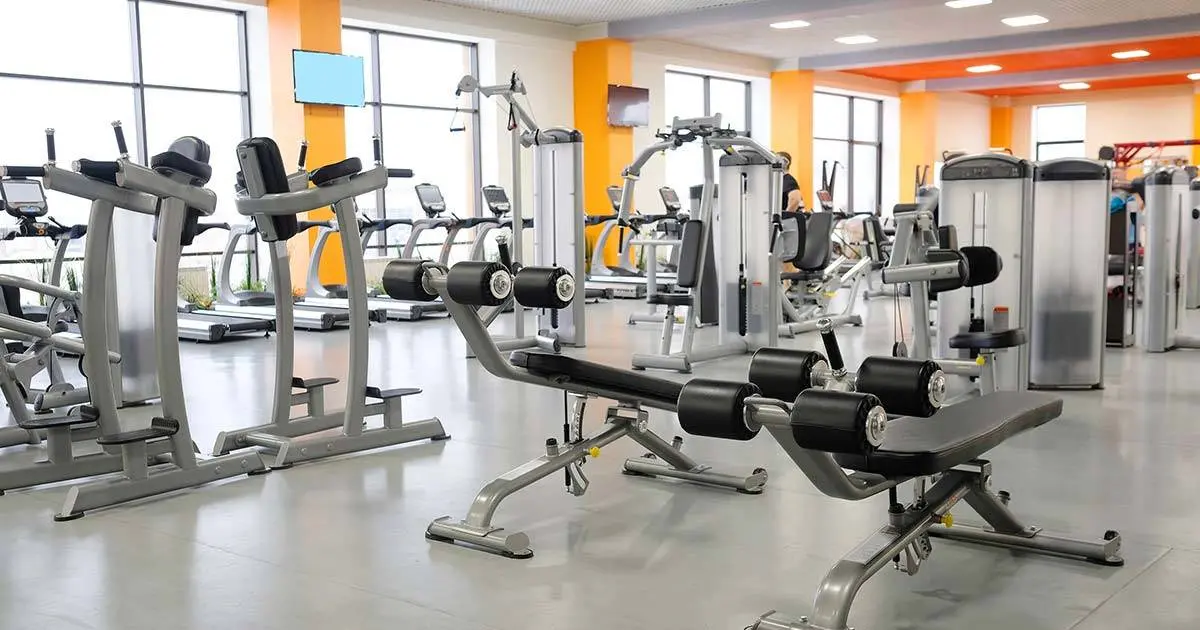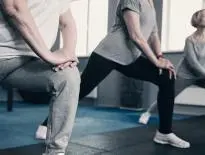Where do you start?
Well, if you’re like many, most of the gym machines are foreign to you. And the bro working the floor is more interested in flexing for his Insta selfie than helping you.
Or you might be very introverted and just don’t feel like asking for help. That was me so many years ago. I completely relate.
I decided to put together a list of the most common exercise machine names with pictures and tips. Consider it the Cliff Notes on how to use gym equipment. I hope it helps you get more out of your gym experience. Click here to download a free pdf copy of this article to keep as a reference before going to the gym.
I’ll not waste any more time. Onward…
Types of weight machines
Typically, there are three types of weight machines, free weights, plate loaded and selectorized. Plate loaded machines require you to add plates yourself. The most common free weight equipment includes squat racks, bench presses, and power racks.
Selectorized machines have a stack of weights that you use a pin to select your working weight.
I’ll lump all of the types of machines together, but separate muscle groups.
Leg & hip workout machines
![Learn How to Use Gym Equipment [The Definitive Guide] 1 Learn How to Use Gym Equipment [The Definitive Guide] 1](https://www.gymfailedyou.com/wp-content/uploads/2019/09/how-to-use-leg-press-machine.jpg.webp)
Leg Press
This is also known as a hip sled. Some of the key points to keep in mind are:
Place your feet high enough on the sled, so that your knees do not pass over your toes. If you can’t see your toes at the bottom of the movement, your feet are too low.
Go as deep as you can without your pelvis lifting up out of the seat.
Avoid locking your knees at the top of the repetition if it’s heavier than your bodyweight.
The leg press also works well for calf raises by placing your toes on the bottom edge and articulating your ankle.
AVOID doing half a rep. A full range of motion will really help keep your hips flexible.
AVOID doing more weight than you can take through a full range of motion.
![Learn How to Use Gym Equipment [The Definitive Guide] 2 Learn How to Use Gym Equipment [The Definitive Guide] 2](https://www.gymfailedyou.com/wp-content/uploads/2019/09/how-to-use-knee-extension-machine.jpg.webp)
Knee extension
Some of the more important points to keep in mind with the knee extension machine are:
Take your lower leg through the full range of motion from bottom to top. If you’re using it for rehab, you’ve already been instructed limit your range of motion if necessary.
Keep your abdomen tight, so that your hips don’t move during the exercise.
Pull your toes up toward your head during the movement.
![Learn How to Use Gym Equipment [The Definitive Guide] 3 Learn How to Use Gym Equipment [The Definitive Guide] 3](https://www.gymfailedyou.com/wp-content/uploads/2019/09/how-to-use-hamstring-curl-machine.jpg.webp)
Prone ham curl
The most important points to consider:
Make sure your kneecap is just over the edge of the bench, i.e., the fulcrum (your knee) should close to the edge.
During the execution of the movement, tighten your abdomen, so that your pelvis doesn’t rise off the bench. We call that “volcano butt” in my studio.
Seated ham curl
Not all gyms have this piece of equipment, but it’s a decent hamstring machine. One key point:
During the movement, lock your abdomen, so that your pelvis doesn’t move.
Standing leg curl hamstrings machine
This is another piece of equipment that is less mainstream. And it’s strange looking! A few things to keep in mind:
Make sure the front of your thigh remains in contact with the pad during the execution of the repetition.
Completely bend the knee at the top of the movement and fully straighten your knee at the bottom of the movement.
![Learn How to Use Gym Equipment [The Definitive Guide] 4 Learn How to Use Gym Equipment [The Definitive Guide] 4](https://www.gymfailedyou.com/wp-content/uploads/2019/09/how-to-use-seated-calf-raise-machine.jpg.webp)
Seated calf raise
This particular leg machine is also a less common leg machine. The only suggestion I can make is to take your foot through a full range of motion. In other words, stretch at the bottom and raise to the tiptoes.
Donkey calf machine
I agree it’s a strange name for a leg exercise machine! And it’s not very uncommon in gyms. But the gist requires one to bend forward at the hips and place the pad on their lumbar. Then treat the movement no different than a calf raise on a leg press or seated calf machine.
![Learn How to Use Gym Equipment [The Definitive Guide] 5 Learn How to Use Gym Equipment [The Definitive Guide] 5](https://www.gymfailedyou.com/wp-content/uploads/2019/09/how-to-use-hack-squat-machine.jpg.webp)
Hack Squat Machine
You’ll find this leg machine in a lot of gyms. The important points to consider are:
Keep your feet far enough toward the top of the platform to prevent your knees from angling past your toes.
Force your spine into the back pad to keep good alignment.
Avoid a depth that allows your pelvis to tilt off the padding.
![Learn How to Use Gym Equipment [The Definitive Guide] 6 Learn How to Use Gym Equipment [The Definitive Guide] 6](https://www.gymfailedyou.com/wp-content/uploads/2019/09/how-to-use-super-squat-machine.jpg.webp)
Super Squat Machine
I’m a big fan of the leg exercise machine as a variation to back squats. A few key points to consider:
Place your feet forward enough on the platform, so that your knees do not pass over your toes. If you can’t see your toes at the bottom of the movement, your feet are too far back.
Go as deep as you can without your pelvis tilting forward.
Avoid locking your knees at the top of the repetition if it’s heavier than your bodyweight.
AVOID doing half a rep. A full range of motion will really help keep your hips flexible.
AVOID doing more weight than you can take through a full range of motion.
![Learn How to Use Gym Equipment [The Definitive Guide] 7 Learn How to Use Gym Equipment [The Definitive Guide] 7](https://www.gymfailedyou.com/wp-content/uploads/2019/09/how-to-use-horizontal-leg-press.jpg.webp)
Horizontal leg press
This particular piece of leg equipment is very common in big box gyms. It’s safer and more user-friendly. The important points to remember are:
Keep your feet high enough on the platform to prevent your knees from going beyond your toes.
Keep your glutes and back firmly planted against the bench during motion.
Rotary hip and glute, aka multi hip machine
As far as I’m concerned, the multi hip machine is better left to advanced individuals and therapeutic uses. But if you’re interested in learning its use, this video explains it well. The most important tips are:
Avoid excessive weight
When in doubt, ask for assistance from a knowledgeable trainer
![Learn How to Use Gym Equipment [The Definitive Guide] 8 Learn How to Use Gym Equipment [The Definitive Guide] 8](https://www.gymfailedyou.com/wp-content/uploads/2019/09/how-to-use-glute-machine.jpg.webp)
Glute machine
There are several variations of this leg machine, but they all share the same principle. The movement resembles a “donkey kick.” A few tips to this movement include:
Make sure your back, including your lumbar, remains flat, not rounded.
The less your hip/pelvis torques/rotates the better.
You should feel this in the glute of your moving leg, not your lumbar.
![Learn How to Use Gym Equipment [The Definitive Guide] 9 Learn How to Use Gym Equipment [The Definitive Guide] 9](https://www.gymfailedyou.com/wp-content/uploads/2019/09/how-to-use-abductor-adductor-machine.jpg.webp)
Adductor/Abductor machine
Sometimes this machine is a two in one and sometimes they’re separate machines. Nonetheless, they’re designed to work your inner and outer thighs (adductors and abductors). This is another leg machine that I believe is best left to therapy and advanced individuals. It’s easy to create imbalances in the hips if used improperly. The most important point about the use of this leg machine is:
Use a weight light enough to execute 12-20 reps.
![Learn How to Use Gym Equipment [The Definitive Guide] 10 Learn How to Use Gym Equipment [The Definitive Guide] 10](https://www.gymfailedyou.com/wp-content/uploads/2019/09/how-to-use-glute-ham-machine.jpg.webp)
Glute/ham machine (bodyweight)
I get it, this is an intimidating leg machine. In fact, most newer gym-goers look at it and scratch their heads. Understandable! But it’s a great and unique position that really taxes the hamstrings. It can also be scary for first-time users. I highly recommend getting assistance from a knowledgeable trainer. Two important points:
Focus on going very slowly during the eccentric phase of the movement. That’s the part that you’re lowering yourself by extending the knee.
Second, keep your lumbar as straight as possible during the movement. Hyperextending (arching) your back should be avoided.
Back workout machines
![Learn How to Use Gym Equipment [The Definitive Guide] 11 Learn How to Use Gym Equipment [The Definitive Guide] 11](https://www.gymfailedyou.com/wp-content/uploads/2019/09/how-to-use-seated-cable-row-machine.jpg.webp)
Cable Row machine
The cable row machine is a very popular machine in most gyms. It definitely has some value. There are several suggestions I’d like to make about using the back exercise machine.
It’s paramount that your back remains in a straight posture. No rounding forward.
Focusing on squeezing between the bottom of your shoulder blades will give the best results.
Make sure to pull the bar all the way into the bottom of your sternum.
![Learn How to Use Gym Equipment [The Definitive Guide] 12 Learn How to Use Gym Equipment [The Definitive Guide] 12](https://www.gymfailedyou.com/wp-content/uploads/2019/09/how-to-use-t-bar-row-machine.jpg.webp)
T-Bar row
These two machines are both the same thing. One includes support for your torso and the other does not. Both are great back exercise machines. Several points to consider:
When using the padded machine, keep your torso glued to the pad at the top of the movement and focus on squeezing the lower shoulder blades together.
When using the T-Bar row without the support, it’s paramount that your back is flat rather than rounded. When bending for the movement, hinge at the hips, not the lumbar.
![Learn How to Use Gym Equipment [The Definitive Guide] 13 Learn How to Use Gym Equipment [The Definitive Guide] 13](https://www.gymfailedyou.com/wp-content/uploads/2019/09/how-to-use-lat-pulldown.jpg.webp)
Lat Pulldown
All three of the back exercise machines above are lat pulldowns. This is perhaps the most common exercise machine in any gym. They all share the same principals.
Make sure you pull the bar/handles all the down to your collar bones.
Avoid tilting backward. Rather keep your torso straight with good posture.
Focus on squeezing the bottom of your shoulder blades together.
At the top of the movement, fully extend your elbows.
![Learn How to Use Gym Equipment [The Definitive Guide] 14 Learn How to Use Gym Equipment [The Definitive Guide] 14](https://www.gymfailedyou.com/wp-content/uploads/2019/09/how-to-use-back-extension-machine.jpg.webp)
Lower back machine
Not every gym has this particular piece of equipment, but enough do to familiarize yourself with the back extension machine. I certainly prefer deadlifts to this exercise, but not everyone can do deadlifts. The only two points to be mindful of are:
Make sure your pelvis is locked tight in the seat and
Avoid hyperextending too far under heavyweight.
Chest & shoulder workout machines
![Learn How to Use Gym Equipment [The Definitive Guide] 15 Learn How to Use Gym Equipment [The Definitive Guide] 15](https://www.gymfailedyou.com/wp-content/uploads/2019/09/how-to-use-bench-press.jpg.webp)
Bench Press and Incline Bench Press
Despite that the bench press is not a machine, it still deserves some key points.
Always use a spotter if you’re uncomfortable with the weight you’re attempting.
The bar should be lowered all the way to the chest for a full range of motion.
The grip width changes the percentage of pec, deltoid and tricep involvement, i.e., wide equals more pecs and less triceps and close equals more triceps/deltoid and less pecs.
![Learn How to Use Gym Equipment [The Definitive Guide] 16 Learn How to Use Gym Equipment [The Definitive Guide] 16](https://www.gymfailedyou.com/wp-content/uploads/2019/09/how-to-use-chest-press-machine.jpg.webp)
Machine chest press
Most gyms have the selectorized version of the machine chest press. A few tips to keep in mind:
Keep your entire back pressed against the pad to avoid leaning into the movement.
Doing either machine one side at a time is a nice variation. Just remember to start with your less dominant side.
At the top of the movement, press your shoulders forward while keeping your back on the bench. As if you’re trying to go that extra few inches.
![Learn How to Use Gym Equipment [The Definitive Guide] 17 Learn How to Use Gym Equipment [The Definitive Guide] 17](https://www.gymfailedyou.com/wp-content/uploads/2019/09/how-to-use-overhead-press-machine.jpg.webp)
Overhead shoulder press machine
Just about every gym has an overhead shoulder press machine. A few things to keep in mind:
Avoid too heavy a weight to minimize excessive upper trap involvement.
Like most other exercises, keep your back glued to the bench, maintaining good posture.
![Learn How to Use Gym Equipment [The Definitive Guide] 18 Learn How to Use Gym Equipment [The Definitive Guide] 18](https://www.gymfailedyou.com/wp-content/uploads/2019/09/how-to-use-shoulder-bench-press.jpg.webp)
Overhead shoulder press bench
Like the bench press, this equipment deserves some “key points.”
Avoid too heavy a weight to minimize excessive upper trap involvement.
Again, like most other exercises, keep your back glued to the bench, maintaining good posture.
Arm exercise machines
![Learn How to Use Gym Equipment [The Definitive Guide] 19 Learn How to Use Gym Equipment [The Definitive Guide] 19](https://www.gymfailedyou.com/wp-content/uploads/2019/09/how-to-use-bicep-curl-machine.jpg.webp)
Biceps curl machine
Although not in every gym, most gyms will have some type of biceps curl machine. The only suggestions I can make for this biceps exercise machine are:
At the bottom of the curl, completely extend the elbows for a full range of motion.
At the top of the movement, completely bend the elbows for a full range of motion.
![Learn How to Use Gym Equipment [The Definitive Guide] 20 Learn How to Use Gym Equipment [The Definitive Guide] 20](https://www.gymfailedyou.com/wp-content/uploads/2019/09/how-to-use-tricep-extension-machine.jpg.webp)
Triceps extension machine
Triceps extension equipment is also found in most gyms. The two most important tips are:
Completely straighten your elbows at the bottom of the movement.
Keep the back of your arms glued to the bench pad.
![Learn How to Use Gym Equipment [The Definitive Guide] 21 Learn How to Use Gym Equipment [The Definitive Guide] 21](https://www.gymfailedyou.com/wp-content/uploads/2019/09/how-to-use-seated-dip-machine.jpg.webp)
Seated dip machine
Another less common arm machine is the seated dip machine for triceps. I like this movement because it also strengthens the muscles that depress your shoulders (pull them down). We tend to be overdeveloped in the muscles that raise our shoulders, which leads to problems. Keep in mind:
Completely straighten your arms at the bottom of the movement for a full range of motion.
At the bottom of the movement push your shoulders down toward the floor without moving your back off the bench. Again, this depression movement is beneficial.
Abdominal or core exercise machines
Abdominal crunch machine
I’m not a fan of this overused abdominal machine since it tends to overdevelop the abdomen and cause imbalances. It’s also assumed by too many that one can spot reduce fat away by using this piece of equipment. I can’t wait until that myth disappears! This ab machine is common enough to highlight some points.
Avoid excessive use of this machine. Once a week is more than enough.
Take it through the biggest range of motion you can without disconnecting from the pads.
![Learn How to Use Gym Equipment [The Definitive Guide] 14 Learn How to Use Gym Equipment [The Definitive Guide] 14](https://www.gymfailedyou.com/wp-content/uploads/2019/09/how-to-use-back-extension-machine.jpg.webp)
Back extension machine
I mentioned this machine earlier. It belongs under both sections. Again, I certainly prefer deadlifts to this exercise, but not everyone can do deadlifts. The only two points to be mindful of are:
Make sure your pelvis is locked tight in the seat and
Avoid hyperextending too far under heavyweight.
Multiple application machines
![Learn How to Use Gym Equipment [The Definitive Guide] 23 Learn How to Use Gym Equipment [The Definitive Guide] 23](https://www.gymfailedyou.com/wp-content/uploads/2019/09/how-to-use-squat-rack.jpg.webp)
Squat Rack
Because of the versatility of this machine, there are too many points to even list. It’s best to have a knowledgeable trainer teach you how to properly use this equipment.
![Learn How to Use Gym Equipment [The Definitive Guide] 24 Learn How to Use Gym Equipment [The Definitive Guide] 24](https://www.gymfailedyou.com/wp-content/uploads/2019/09/how-to-use-smith-machine.jpg.webp)
Smith machine
Much like the squat rack, there are copious amounts of exercises one can execute on the smith machine. So, too many points to list.
![Learn How to Use Gym Equipment [The Definitive Guide] 25 Learn How to Use Gym Equipment [The Definitive Guide] 25](https://www.gymfailedyou.com/wp-content/uploads/2019/09/how-to-use-cable-crossover.jpg.webp)
Cable crossover/multi cable functional trainer
There are very few limits to the number of cable exercises one can do with this equipment. Regardless of which exercise you’re doing, please avoid slamming the weight when you’re finished. That’s just poor gym etiquette!
Conclusion
Now that you’re armed with so many workout machine names along with some tips, you’re ready to go with confidence. There’s nothing every wrong with asking for help from a good trainer.
In fact, gym rats tend to praise novices who ask for help. And the staff really appreciates it since it minimizes injuries and liability. It’s also a good way to establish some comradery with the staff. That is unless the staff is more interested in their own selfies posing…
This may not be the most technical article, but I hope it helps raise your confidence when walking into a gym for the first time. I understand how scary that can be for most people.
Acknowledgments
I would like to sincerely thank our friends at EnerG Wellness Dynamic Fitness Solutions for the use of equipment pictures.




